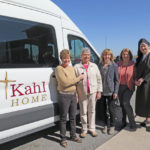By Glenn Leach
For The Catholic Messenger
My involvement in disaster preparation began when Ann Mohr, a fellow parishioner at St. Ann Parish in Long Grove, arranged with Catholic Charities of New Orleans for a team of us to help out in the wake of Hurricane Katrina. We learned that working with an organization such as Catholic Charities, which is tied into the network of responders, is a critical part of helping out.

They told us what clothes, tools and supplies to bring and arranged for meals and sleeping quarters in a flood-damaged Catholic school. Other enthusiastic volunteers had to be turned away as they had no tools or appropriate work clothes and planned to stay and eat in motels and restaurants that no longer existed. Because Catholic Charities was tied into the response network, they were able to assign us to specific locations with work that needed to be done by folks with tools but not more prior training than we had.
The tornado that wrecked St. Patrick Catholic Church in Iowa City in 2006 and the extensive flooding of many counties of the Diocese of Davenport in 2008 provided more exposure to the good and the bad of disaster preparation. As a volunteer with the diocese’s Social Action Department, I assisted diocesan efforts to reach out to those affected. This involved working with county and city groups with prior disaster recovery experience and the heartbreak of working with communities that lacked preparation. As I worked with the long-term recovery groups and the Federal Emergency Management Agency, I recognized two key factors that impact communities’ recovery: the degree of preparation and the faith communities.
The brunt of the long-term recovery work is managed by religious organizations. Without volunteers, preferably trained volunteers, recovery is slow, painful and incomplete. Virtually every faith denomination — Christian, Jewish and Muslim — has at its upper levels, a designated disaster response capability. Over the years, various denominations have specialized in disaster case management, mobile feeding kitchens, mobile laundries, clean-up, rebuilding teams and many others. After the disaster no longer occupies the headlines, these responders remain helping the families.
I recently attended a meeting of the state organization that fosters coordination between the many groups active in preparation for disaster from across the state at the command center in the Iowa Joint Forces Headquarters. A guest speaker from the State of Georgia described the Georgia program to facilitate faith-based disaster preparations and response.
“People from the faith communities will always be there when bad things happen to people,” she said. “Why not have them trained and ready?” She described what is asked of churches (or mosques or temples) seeking state assistance in training.
• Protection of the place of worship. A plan for its vital records, sacred vessels, alternate places of worship and protection of worshipers in the building at the time. A plan to reach out to individuals with special needs that the church knows of.
• Assisting congregational families to plan: Insurance records, key prescriptions, deeds and inventories needed to claim damages, several days of emergency supplies, plans to reunite if scattered when disaster hits.
• What the church or its people can do as members of the larger community: provide trained volunteers, act as a temporary shelter or feeding site for victims or volunteers, and that critical need, spiritual counseling.
I have taken on the assignment to talk to parishes about this form of ministry, to encourage them to plan, to protect their families, and to be as the Holy Father has said a church of outreach, a living example of mercy. To do this, I will be sending a series of ideas for this ministry and contacting parishes to see what connections we can make together to make this ministry a reality.











